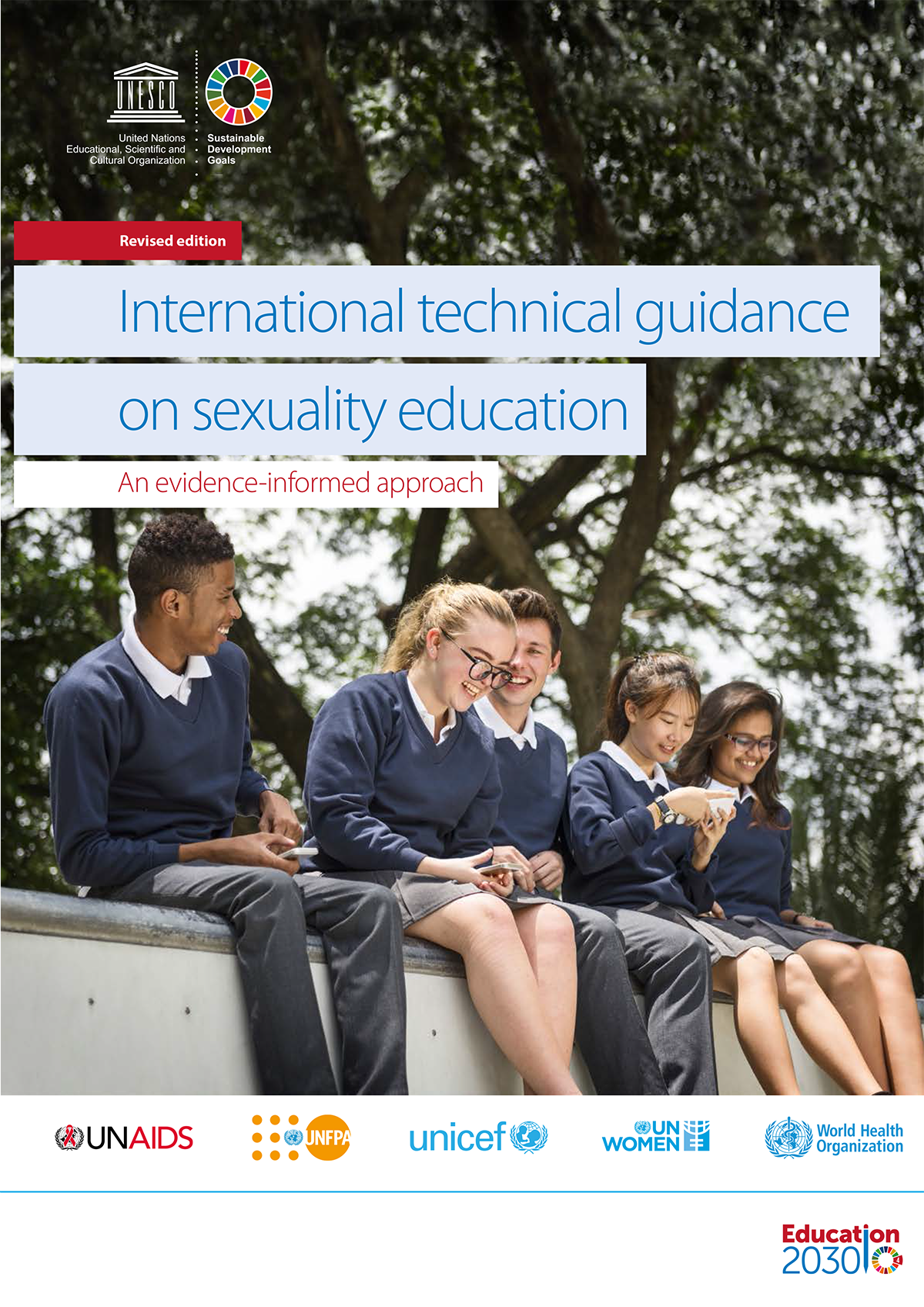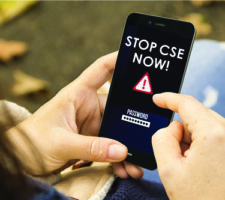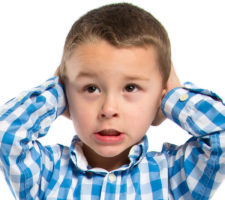
TARGET AGE GROUP: 5 – 15 year-olds
PUBLISHER: UNESCO
UN AGENCIES: UNESCO, UNICEF, WHO, UNAIDS, UNFPA, UN Women
CONTRIBUTOR: International Planned Parenthood Federation
HARM SCORE: 15 OUT OF 15
DISTRIBUTION: GLOBAL
Direct Quotes from the Publication
This publication received a Harm Score of 15 out of 15 (click here to see analysis). To learn more about the Harmful Elements commonly found in CSE programs or the 15 Harmful Elements Analysis Tool click here.
Distorts Abstinence
- “[U]nderstand that abstinence means choosing not to have sex, or deciding when to start having sex and with whom, (Pg. 71, Learning objectives 9-12 years)
- “[A]bstinence is not a permanent condition in the lives of many young people.” (Pg. 18, 2.2—Other key considerations in the evolving field of CSE)
- “Abstinence-only programmes have been found to be ineffective and potentially harmful to young people’s sexual and reproductive health and rights.” (Pg. 18)
Promotes Early Sex and Promiscuity
- “[Y]oung people want and need sexuality and sexual health information as early and comprehensively as possible …” (Pg. 35, 5.1—Goals, age groups and structure)
- “CSE promotes the right to choose when and with whom a person will have any form of intimate or sexual relationship …” (Pg. 18, Other key considerations)
- “[R]ecognize that each person’s decision to be sexually active is a personal one, which can change over time and should be respected at all times.” (Pg. 71, Learning objectives 12-15 years)
- “[D]emonstrate respect for diverse practices related to sexuality” (Pg. 48, Learning objectives 9-12 years)
- “[R]ecognize that informed sexual decision-making (i.e. being knowledgeable and confident in deciding if, when and with whom to become sexually active) is important to their health and well-being” (Pg. 71, Learning objectives 12-15 years)
- “[N]on-penetrative sexual behaviours are without risk of unintended pregnancy, offer reduced risk of STIs, including HIV, and can be pleasurable” (Pg. 72, Learning objectives 12-15 years)
- “[S]upport the right for everyone … to express their sexual feelings” (Pg. 78, Learning objectives 12-15 years)
- CSE can “help children and young people form respectful and healthy relationships with … romantic or sexual partners.” (Pg. 17, 2.1—What is comprehensive sexuality education (CSE)?)
- “aims to equip children and young people …” to “develop respectful social and sexual relationships” (Pg. 16, 2.1 What is comprehensive sexuality education (CSE)?)
- “during puberty boys and girls become more aware of their responses to sexual attraction and stimulation” (Pg. 71, Learning objectives 9-12 years)
Promotes Transgender Ideology and Respect for Diverse Gender Identities
- “explain how someone’s gender identity may not match their biological sex” (Pg. 50, Learning objectives 9-12 years)
- “demonstrate respect for the gender identity of others” (Pg. 50, Learning objectives 9- 12 years)
- “define gender and biological sex and describe how they are different” (Pg. 50, Learning objectives 5-8 years)
- “reflect on how they feel about their biological sex and gender” (Pg. 50, Learning objectives 5-8 years)
- “CSE contributes to gender equality by building awareness of the centrality and diversity of gender in people’s lives.” (Pg. 17, 2.1—What is comprehensive sexuality education (CSE)?)
- “define homophobia and transphobia” (Pg. 50, Learning objectives 15-18 years)
- “analyze social norms that contribute to homophobia and transphobia and their consequences” (Pg. 50, Learning objectives 15-18+ years)
- “demonstrate ways to show support for people experiencing homophobia or transphobia” (Pg. 50, Learning objectives 15-18+ years)
Promotes Affirmation of Diverse Sexual Orientations
Please note: These quotes related to violence and discrimination should not be interpreted as a Family Watch endorsement of violence. Family Watch has a longstanding policy position that we oppose violence and unjust discrimination against persons based on their sexual orientation or gender identity. These quotes are here as an example of what children are being taught, and often CSE purposely presents LGBTI issues in the context of LGBTI persons as victims, and then goes on to encourage expression of any sexual orientation or gender identity at any age, regardless of the health consequences.
- “all people should be able to love who they want” (Pg. 50, Learning objectives 15-18+ years) [Note: While we agree with this statement this is a common mantra used to legalize same-sex marriage.]
- “[H]omophobic and transphobic violence is a form of school related gender-based violence” (Pg. 23, Children’s, young people’s SHRH) [Note: While this can be true, and violence should be prevented, CSE proponents have been known to characterize beliefs, such as marriage between a man and a woman or that biological males cannot become females, as a form of hate or violence.]
- “severe restrictions and penalties imposed on LGBTI people” (Pg. 25, Lesbian, gay, bisexual, transgender and intersex) [Note: Man/woman marriage laws have been considered to be “severe restrictions” on LGBTI people, and language like this has been used to repeal man/woman marriage laws.]
- “discrimination and harm on the basis of their sexual orientation, gender identity or expression” (Pg. 25, Lesbian, gay, bisexual, transgender and intersex) [Note: The problem with this is that CSE programs often define discrimination as rooted in religious beliefs regarding marriage and sex.]
- “[H]omophobia and transphobia … lay the groundwork for more vindictive and violent forms of bullying.” (Pg. 25, Lesbian, gay, bisexual, transgender…)
- “acknowledge that discrimination against people who are attracted to the same sex, or who are believed to be attracted to the same sex is wrong and can have negative effects on these individuals” (Pg. 70, Learning objectives 9-12 years) [Note: Again, the problem is how discrimination is defined.]
- “recall examples of gender bias against men, women and people of diverse sexual orientation and gender identity” (Pg. 50, Learning objectives 15-18+ years)
- “Sexuality” encompasses “gender identity; sexual orientation; sexual intimacy; pleasure.” (Pg. 17, 2.1—What is comprehensive sexuality education (CSE)?)
- “diversity in the way young people manage their sexual expression” (Pg. 18, Other key considerations in the evolving field of CSE)
Masturbation
- “[M]any boys and girls begin to masturbate during puberty or sometimes earlier ….” (Pg. 71, Learning objectives 9-12 years)
- “[M]asturbation does not cause physical or emotional harm but should be done in private ….” (Pg. 71, Learning objectives 9-12 years)
Promotes Sexual Rights for Children
- “describe male and female responses to sexual stimulation.” (Pg. 71, Learning objectives 9-12 years)
- “Engaging in sexual behaviours should feel ” (Pg. 72, Learning objectives 15-18+ years)
- “summarize key elements of sexual pleasure and responsibility” (Pg. 72, Learning objectives 15-18+ years)
- “reflect on how gender norms and stereotypes influence people’s expectations and experience of sexual pleasure” (Pg. 72, Learning objectives 15-18+ years)
Teaches Children to Consent to Sexual Behavior
- “demonstrate ways to communicate giving and refusing consent” (Pg. 56, Learning objectives 15-18+ years)
- “Consent is critical for healthy, pleasurable and consensual sexual behaviour with a partner.” (Pg. 56, Learning objectives 15-18+ years)
Promotes Abortion
- “Because of the legal restrictions on access to safe abortion that exist in many parts of the world, adolescents often resort to unsafe procedures administered by unskilled providers.” (Pg. 23, Unsafe Abortion)
- “[A]dolescent girls … are generally less knowledgeable about their rights concerning abortion and post abortion care.” (Pg. 23, Unsafe Abortion)
- “recognize the importance of using contraception correctly, including condoms and emergency contraception” (Pg. 75, Learning objectives 15-18+ years)
- “explain that emergency contraception (where legal and available) can prevent unintended pregnancy” (Pg. 75, Learning objectives 12-15 years)
Condoms and Contraception
- “demonstrate the steps for correct condom use” (Pg. 79, Learning objectives 12-15 years)
- “demonstrate ways to access condoms” (Pg. 80, Learning objectives 15-18+ years)
- “demonstrate confidence in discussing and using different contraceptive methods” (Pg. 75, Learning objectives 15-18+ years)
- “Many curricula fail to provide adequate information about modern contraception – particularly, but not limited to, emergency contraception and female condoms …” (Pg. 91)
Manipulates Values, Attitudes, and Beliefs on Sexuality
- “expectations that govern sexual behaviour differ widely” (Pg. 17, Conceptual framework for sexuality in the context of CSE)
- “… CSE includes ongoing discussions about social and cultural factors … such as gender and power inequalities … sexual orientation and gender identity.” (Pg. 18, 2.2—Other key considerations in the evolving field of CSE)
- “CSE covers the full range of topics … including those that may be challenging in some social and cultural contexts.” (Pg. 16, 2.1— What is comprehensive sexuality education (CSE)?)
- “respect, acceptance, tolerance and empathy, regardless of … sexual orientation, gender identity or expression” (Pg. 17, 2.1—What is comprehensive sexuality education (CSE)?)
- “explore values, attitudes and social and cultural norms and rights impacting sexual and social relationships” (Pg. 34, 5.1—Goals, age groups and structure)
- “Certain behaviours are seen as acceptable and desirable, while others are considered unacceptable. This does not mean … they should be excluded from discussion within the context of sexuality education.” (Pg. 17, Conceptual framework for sexuality in the context of CSE)
- “compare and contrast ways that … religion influence[s] how society views sex, gender and reproduction” (Pg. 65, Learning objectives 12-15 years)
- “identify cultural, religious or social beliefs and practices related to sexuality that have changed over time” (Pg. 48, Learning objectives 9-12 years)
- “question social and cultural norms that impact sexual behaviour in society” (Pg. 48, Learning objectives 12-15 years)
Teaches Children to Question Parents’ Values on Sexuality
- “differentiate between values that they hold, and that their parents/guardians hold about sexuality” (Pg. 46, Learning objectives 15-18+ years)
- “acknowledge that some of their values may be different from their parents/guardians” (Pg. 46, Learning objectives 15-18+ years)
Other Resources
Related Family Watch Policy Briefs:
- Comprehensive Sexuality Education: Sexual Rights vs. Sexual Health (FWI Policy Brief)
- International Planned Parenthood Federation & Children’s “Right” to Sex (FWI Policy Brief)
- Abort Planned Parenthood: End Their Empire of Abortion, Deception, Fraud, and the Sexualization of Children (FWI Special Report)
- The Special Rapporteur on the Right to Education (FWI Policy Brief)
- The International Guidelines on Sexuality Education (FWI Policy Brief)
- Protecting Children and the Family from the Global Sexual Rights Revolution (FWI Presentation)





